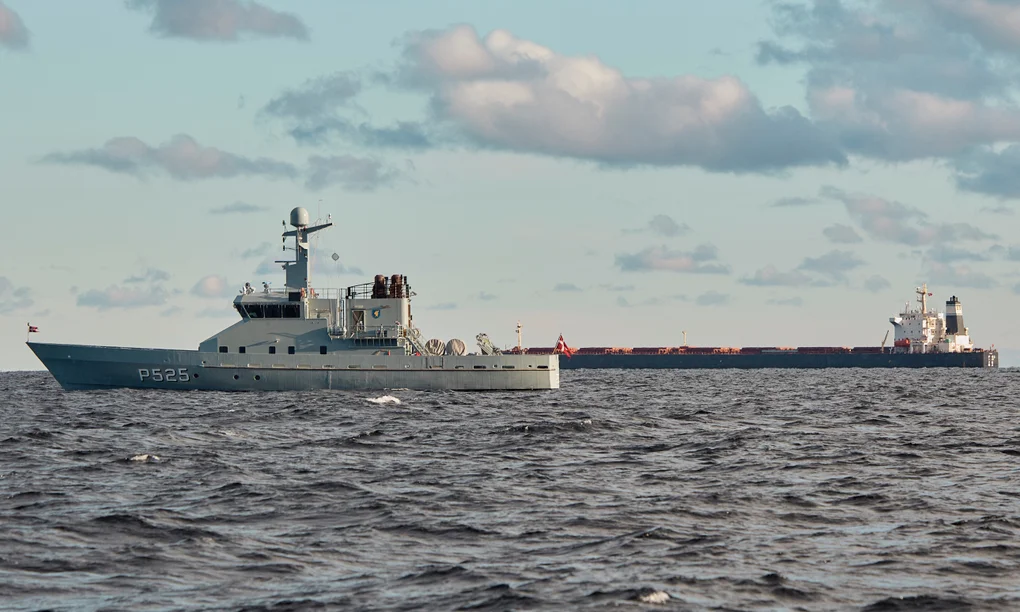Swedish police investigating the believed sabotage of two fibre-optic undersea cables in the Baltic Sea have said a Chinese ship off the coast of Denmark was “of interest” as Danish officials said its navy was shadowing a Chinese-registered cargo ship.
The ship, identified by Denmark as the Yi Peng 3, passed the two cables on Sunday and Monday about the time it is believed they were severed in a suspected malicious attack. The ship has been shadowed by a Danish navy vessel since it was located in waters between Sweden and Denmark.
The Danish defence command said: “The Danish Defence can confirm that we are present in the area near the Chinese ship Yi Peng 3. The Danish Defence currently has no further comments.”
Swedish officials have confirmed they are interested in the ship but did not give further details.
Specialist Swedish underwater search crews were at the site of the Finnish-German cable on Wednesday – one of the two undersea fibre-optic cables that was damaged – gathering evidence for Swedish investigators. A cable between Sweden and Lithuania was also damaged.
Swedish police said a Chinese ship off the coast of Denmark was among those they were looking at. Per Engström at Sweden’s National Operative Department said: “It is part of the sphere of interest, but there may be more.”
He said the Swedish coast guard is assisting with “increased surveillance around the relevant areas”, adding: “We are ready to take investigative measures to get a clearer picture of what may have happened.”
Lin Jian, a spokesperson for China’s foreign ministry, said: “China has consistently and fully fulfilled its obligations as a flag state and requires Chinese vessels to strictly abide by the relevant laws and regulations.”
The Swedish navy said earlier it had an “almost 100% identification” of the ships that were in the area of the two cable breaks.
ccording to Vesselfinder tracking data, the last time the cargo ship, which is owned by Ningbo Yipeng Shipping, a company registered in Ningbo, visited a port was on 15 November in Ust-Luga in western Russia, close to the border with Estonia.
It stopped overnight on Tuesday to Wednesday in the Kattegat strait between Denmark and Sweden.
The Russian maritime pilot Alexander Stechentsev, who had boarded the ship to guide it out of port, said there was nothing unusual about the vessel. The Ust-Luga port authority employee said he took the ship to a receiving buoy located 11 miles offshore before disembarking. He described the Yi Peng 3 vessel as “a standard 225-metre bulk carrier” with a crew of Chinese nationals.
He said: “There was absolutely nothing unusual about the ship.”
A Russian maritime database confirms that he left the Yi Peng 3 vessel on the afternoon of 15 November.
Russia has denied any involvement in the cable incidents. On Wednesday the Kremlin said such accusations were ridiculous and it was absurd to accuse Russia without evidence.
Sweden and Finland are jointly investigating the incidents as potential sabotage, with Sweden leading the investigation.
The Swedish prime minister, Ulf Kristersson, said on Wednesday: “We assume that this could very well be sabotage but we don’t know anything yet. The destroyed cables must be carefully investigated, both by the police and internationally. We have seen sabotage in the past, so we take it very seriously.”
The investigators in Sweden were analysing any potential role by the Chinese ship but the Swedish government did not comment on this. A government source said information on the incident was “moving very quickly”.
Last year, the anchor of another Chinese vessel, the container ship Newnew Polar Bear – was found to have damaged a gas pipeline between Finland and Estonia. Authorities have not said whether they believed the incident to be intentional or accidental.
Overnight, the Swedish navy used unmanned, remote-controlled submarines to investigate the southern site of the two cables, but said it would take “several days” due to the challenges of forecast bad weather and the potential for poor visibility.
Jimmie Adamsson, a Swedish navy spokesperson, said the navy had been asked to support the Swedish prosecutor and police with their investigations and ships were sent out immediately. They have been asked to gather evidence at the sites of the two breaks – one 100-150 metres deep (the Sweden-Lithuania cable) and the other 20-40 metres deep (the Finland-Germany cable). They have also been asked to put together a picture of what vessels were there, and at what time.
The navy’s crew, which is trained to search underwater, has performed similar tasks twice before during the investigation into the suspected sabotage of the Nord Stream pipelines in 2022.
Adamsson said: “Yesterday [Tuesday], a couple of navy ships left the Swedish ports and went to the most southerly point of the two. They have been working throughout the night until the morning. There was a bit of rough weather.”
At any given time, there are about 4,000 large vessels in the Baltic passing over a web of underwater cables transporting data, electricity and gas across Europe.
The Danish prime minister, Mette Frederiksen, has said she was “not surprised” by the potential for sabotage. “If the immediate assessment is that it is sabotage and it comes from outside, then it is obviously serious. I am not surprised that it can happen,” she said.
Germany’s defence minister, Boris Pistorius, has already said he assumed the act was sabotage. “No one believes that the cables were accidentally damaged,” he said.
Sweden’s civil defence minister, Carl-Oskar Bohlin, quickly made the link between the movement of ships and the severed cables. “There are ship movements that correspond to this crime on maritime surveillance,” he said.
The Finnish security intelligence service (Supo) said it was “too early to assess the cause of the cable damage” but it was supporting other authorities with their expertise. It said about 200 submarine cable breakages happened every year, the most common cause being human activities such as fishing or anchoring.
